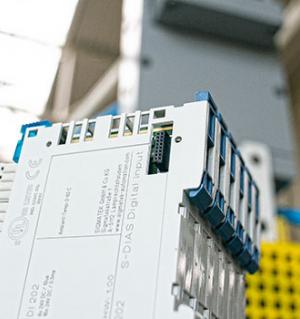Продукция и решения
Wiring Electrical Control Cabinets
Best Practices
How connectors beat hardwiring, saving time and money
Time savings. Cost saving. Cost certainty. Reliability. Ruggedness.Connector-based wiring has significant advantages over hard-wiring connections between machines and electrical control cabinets. Now, these advantages are available for connecting a UL 508-certified cabinet.
- In most scenarios, using connector-based cable assemblies to connect a machine to a panel means less total labor cost.
- That cost is predictable and stable – a one-time investment in materials and labor.
- Connectors are plug and play, installed or removed in no time, assuring fast, reliable setup of a machine at the customer’s location.
- Modular connectors can be user-configured to optimize panel wiring layout and save on materials.
- Connectors are built tough for long service life. Ruggedized connectors are available for virtually all types of harsh or regulated operating environments.
Benefits of Using Connectors
Cost effective
OEM benchmarking confirms that hardwiring is only more cost-effective when electrical connections for a new machine are made once and once only at the machine builder, and don’t have to be unmade for delivery, installation, commissioning or warranty maintenance. Real life is quite different.
- Many larger machines are wired up for assembly and testing at the OEM, then disassembled for shipping in smaller sections because it’s more economical to do so;
- When the machine is disassembled, hard-wired connections to the control panel have to be unmade.
- Re-making those connections in the field takes more time than at the OEM, and typically costs about 30% more. It also carries a significant risk of connection errors, which can result in unforeseen delay and expense.
- Occasionally such an error may even cause damage to the machine or panel during commissioning. More cost and delay.
These pitfalls of hardwiring are well known, but often accepted as “part of doing business” – until the additional time and expense are documented that compare the two wiring approaches.
Building and installing connector-based wiring does cost about 40% more in parts and labor than the first hardwiring of the same connection pairs. However, as soon as those first hard-wired connections are unmade for shipping, cost favorability shifts irreversibly to connectors.
A connectorized cable assembly is disconnected in seconds, then reconnected in seconds at the end user’s facility. No actual electrical connections are unmade inside the panel, so the risk of wiring errors associated with field re-assembly is non-existent.
The first installation cost can be minimized several ways
The initial (first installation) cost differential between hardwiring and connectorization can be minimized several ways:
-
Using a pre-assembled, UL508-compliant cable from HARTING may suit an application just fine.
- Pre-making custom wiring assemblies with connectors allows for precise, repeatable measurement of cable lengths, reducing cable wastage.
- Modular connectors can be used to carry several different voltages and AC and/or DC current, simplifying the internal wiring of the cabinet. Hardwiring alternatives such as mounting terminal blocks inside the cabinet take up more space and add expense.
- Where volume warrants, using automated wire stripping and crimping systems reduces the time for assembling connectorized cables.
- While hardwiring is usually performed by an electrician, custom cable assemblies can be put together by unlicensed personnel.
- Connectorized cable assemblies can be pre-tested to save time on the initial assembly and testing of the machine
So it’s “advantage connectors” for the OEM. But what about end users? From their perspective, connectorization wins hands down. Using connectors results in less downtime during scheduled and unscheduled maintenance events. And there are other potential savings: for example, it costs less to repair severed cables in a connectorized layout, so there is less reason to spend good money protecting them with rigid or semi-rigid conduits.
Suitable for any panel
Connectorization is suitable for any panel
-
Connectors are available for simple or complex wiring jobs, even for panels in harsh environments. Users can employ connectors and cables that are optimized for withstanding extreme conditions like high heat or very cold, or exposure to moisture, direct sunlight, constant vibration or corrosive agents.
- There are connectors for meeting clean-room, sanitary and other regulatory standards.
- Just about any enclosure can be set up for connectorized wiring at no additional cost. This includes cabinets from manufacturers like Rittal, Hoffman, Hammond, Takachi and many more.
- Many HARTING connectors are rectangular. Rectangular connectors can fit nicely over standard circular panel cutouts, or the enclosure can be ordered with rectangular cutouts. Rectangular connectors can accommodate very large cable diameters securely, with a choice of straight or side entry for superior strain relief over circular connectors or hard-wired cables.




